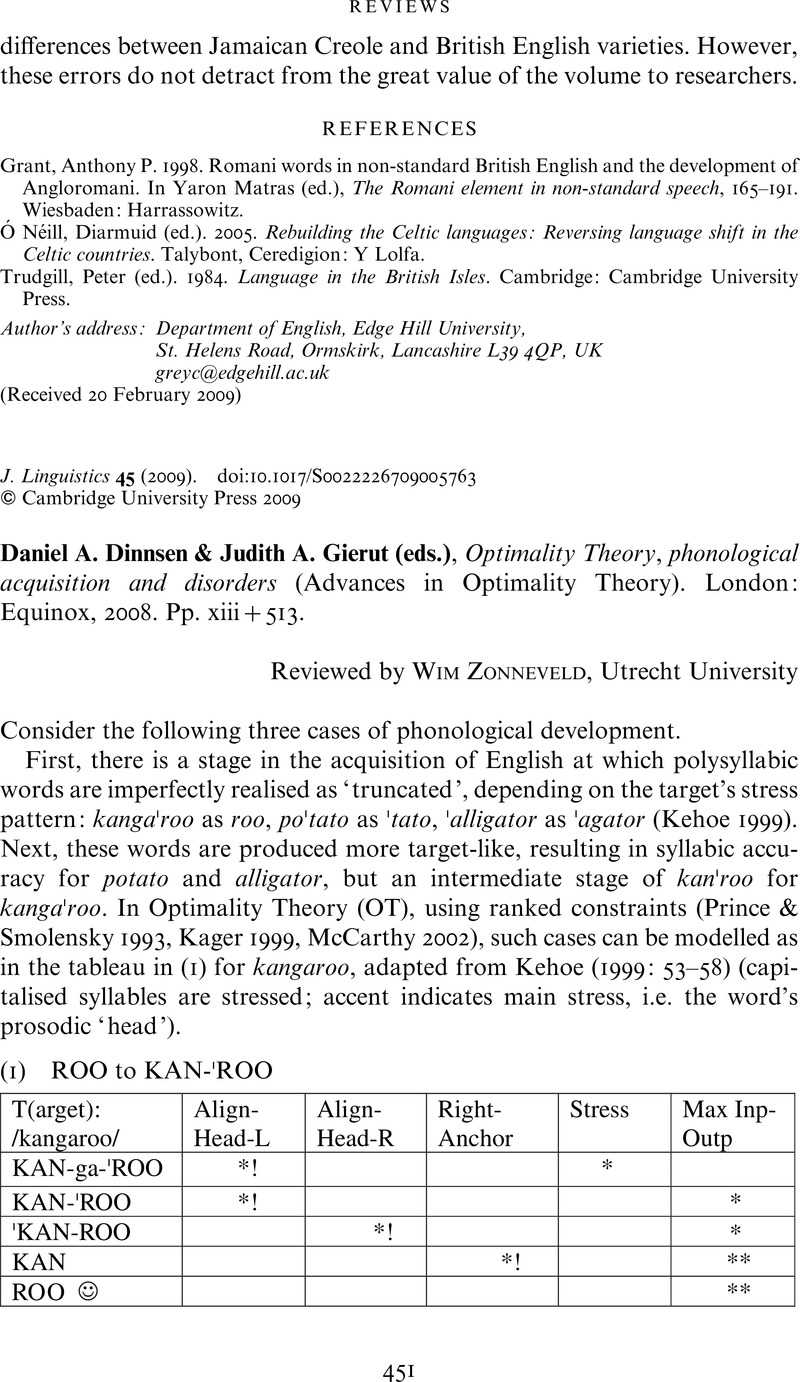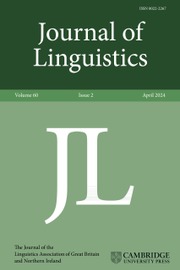No CrossRef data available.
Article contents
Daniel A. Dinnsen & Judith A. Gierut (eds.), Optimality Theory, phonological acquisition and disorders (Advances in Optimality Theory). London: Equinox, 2008. Pp. xiii+513.
Published online by Cambridge University Press: 04 June 2009
Abstract
An abstract is not available for this content so a preview has been provided. Please use the Get access link above for information on how to access this content.

- Type
- Reviews
- Information
- Copyright
- Copyright © Cambridge University Press 2009
References
REFERENCES
Anttila, Arto & Cho, Young-mee Yu. 1998. Variation and change in Optimality Theory. Lingua 104.1/2, 31–56.CrossRefGoogle Scholar
Baertsch, Karen & Davis, Stuart. 2003. The split margin approach to syllable structure. ZAS Papers in Linguistics 32, 1–14.CrossRefGoogle Scholar
Beckman, Jill N. 1998. Positional faithfulness. Ph.D. dissertation, University of Massachusetts, Amherst.Google Scholar
Benua, Laura. 1997. Transderivational identity: Phonological relations between words. Ph.D. dissertation, University of Massachusetts, Amherst.Google Scholar
Chomsky, Noam & Halle, Morris. 1968. The sound pattern of English. New York: Harper & Row.Google Scholar
Kehoe, Margaret M. 1999. Truncation without shape constraints: The latter stages of prosodic acquisition. Language Acquisition 8.1, 23–67.Google Scholar
Kiparsky, Paul. 1976. Abstractness, opacity, and global rules. In Koutsoudas, Andreas (ed.), The application and ordering of grammatical rules, 160–186. The Hague: Mouton.Google Scholar
Lacy, Paul de. 2006. Markedness: Reduction and preservation in phonology. Cambridge: Cambridge University Press.CrossRefGoogle Scholar
Leonard, Laurence B. & Brown, Barbara L.. 1984. Nature and boundaries of phonologic categories: A case study of an unusual phonologic pattern in a language-impaired child. Journal of Speech and Hearing Disorders 49.4, 419–428.CrossRefGoogle Scholar
Lleó, Conxita & Prinz, Michael. 1997. Syllable structure parameters and the acquisition of affricates. In Hannahs, S. J. & Young-Scholten, Martha (eds.), Focus on phonological acquisition, 143–163. Amsterdam & Philadelphia: John Benjamins.Google Scholar
Lombardi, Linda. 1999. Positional faithfulness and voicing assimilation in Optimality Theory. Natural Language & Linguistic Theory 17.2, 267–302.CrossRefGoogle Scholar
Łubowicz, Anna. 2002. Derived environment effects in Optimality Theory. Lingua 112.4, 243–280.CrossRefGoogle Scholar
McCarthy, John J. 1999. Sympathy and phonological opacity. Phonology 16.3, 331–399.CrossRefGoogle Scholar
McCarthy, John J. 2002. A thematic guide to Optimality Theory. Cambridge: Cambridge University Press.Google Scholar
McCarthy, John J. 2003. What does comparative markedness explain, what should it explain, and how? Theoretical Linguistics 29.1/2, 141–155.Google Scholar
McCarthy, John J. 2007. Hidden generalizations: Phonological opacity in Optimality Theory. London: Equinox.Google Scholar
McCarthy, John J. & Prince, Alan S.. 1994. The emergence of the unmarked: Optimality in prosodic morphology. The North East Linguistic Society (NELS) 24, 333–379.Google Scholar
McCarthy, John J. & Prince, Alan S.. 1995. Faithfulness and reduplicative identity. University of Massachusetts Occasional Papers in Linguistics 18, 249–384.Google Scholar
Prince, Alan S. & Smolensky, Paul. 1993. Optimality Theory: Constraint interaction in generative grammar (Rutgers Center for Cognitive Science Technical Report 2). Piscataway, NJ: Center for Cognitive Science, Rutgers University. [Report available at http://roa.rutgers.edu/view.php3?roa=537. Revised version published by Blackwell, Oxford, 2004].Google Scholar
Smith, N. V. 1973. The acquisition of phonology: A case study. Cambridge: Cambridge University Press.Google Scholar
Smolensky, Paul. 1995. On the internal structure of the constraint component Con of UG. Presented at UCLA. [ROA 86.]Google Scholar


